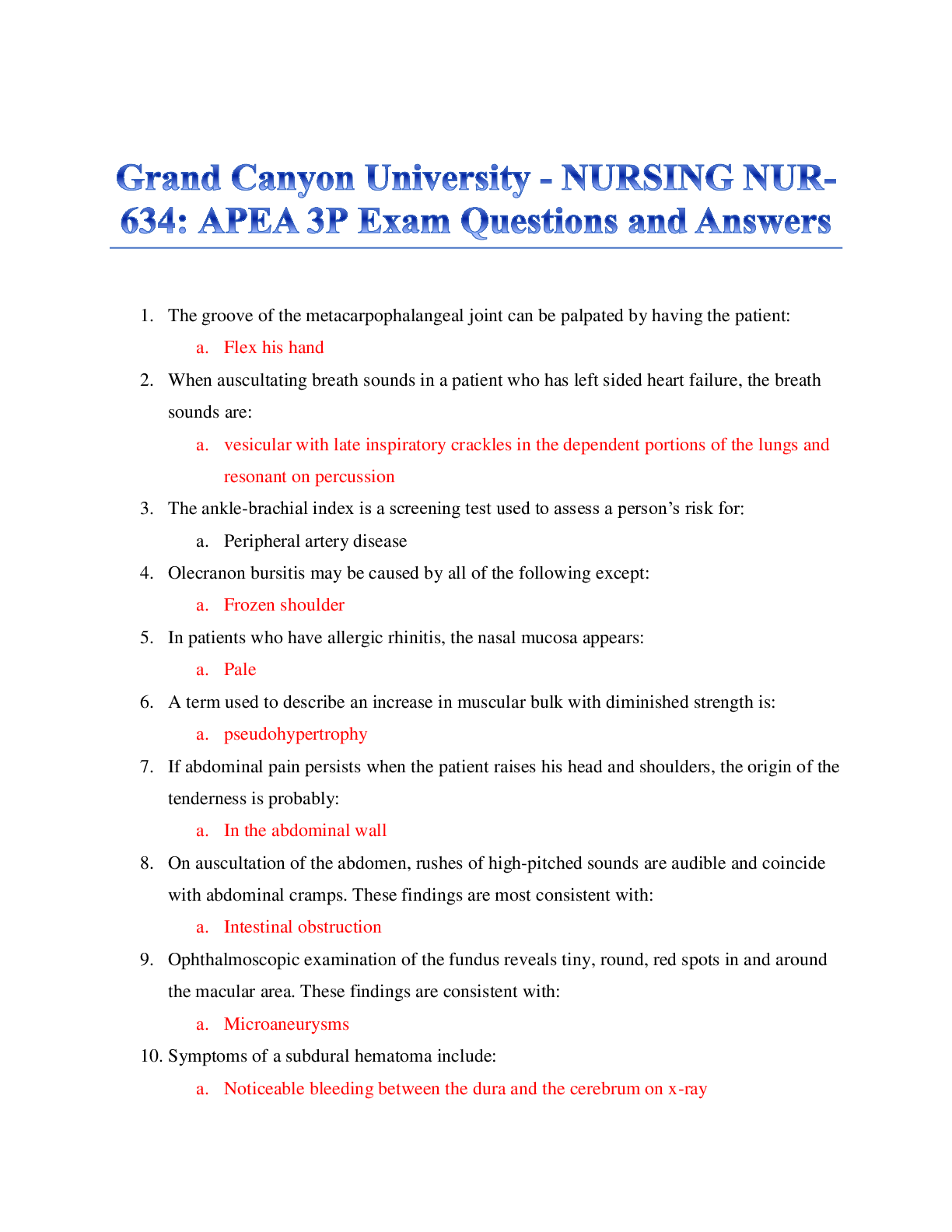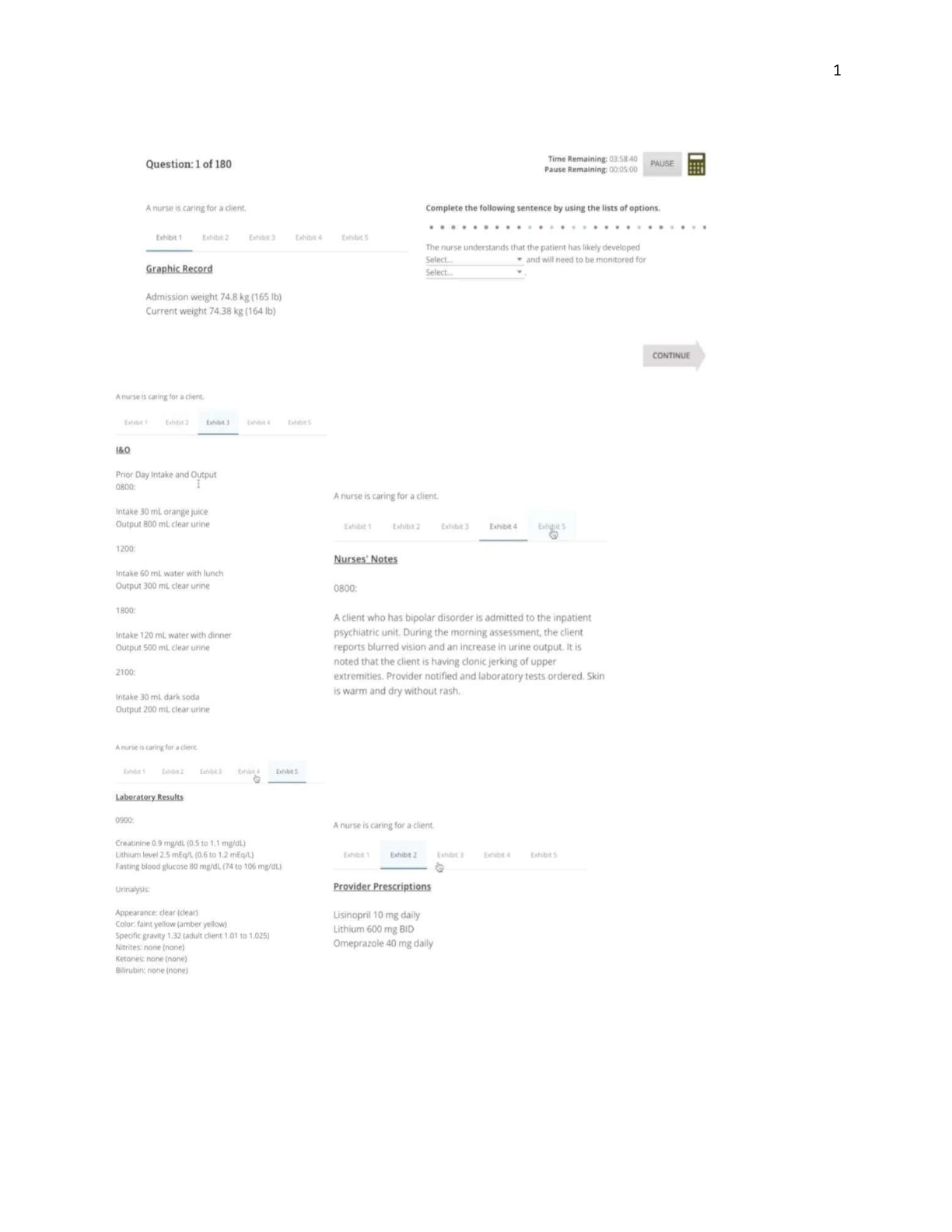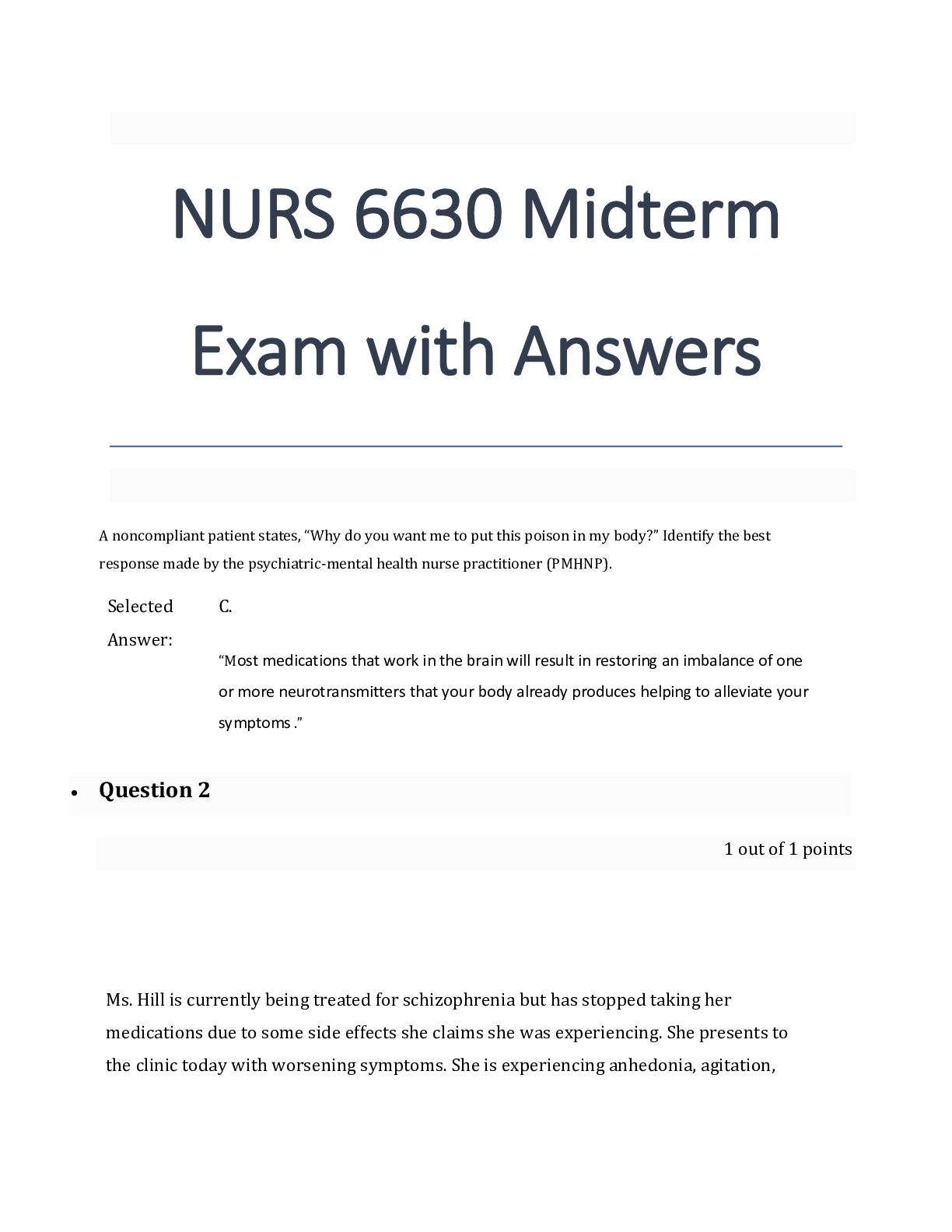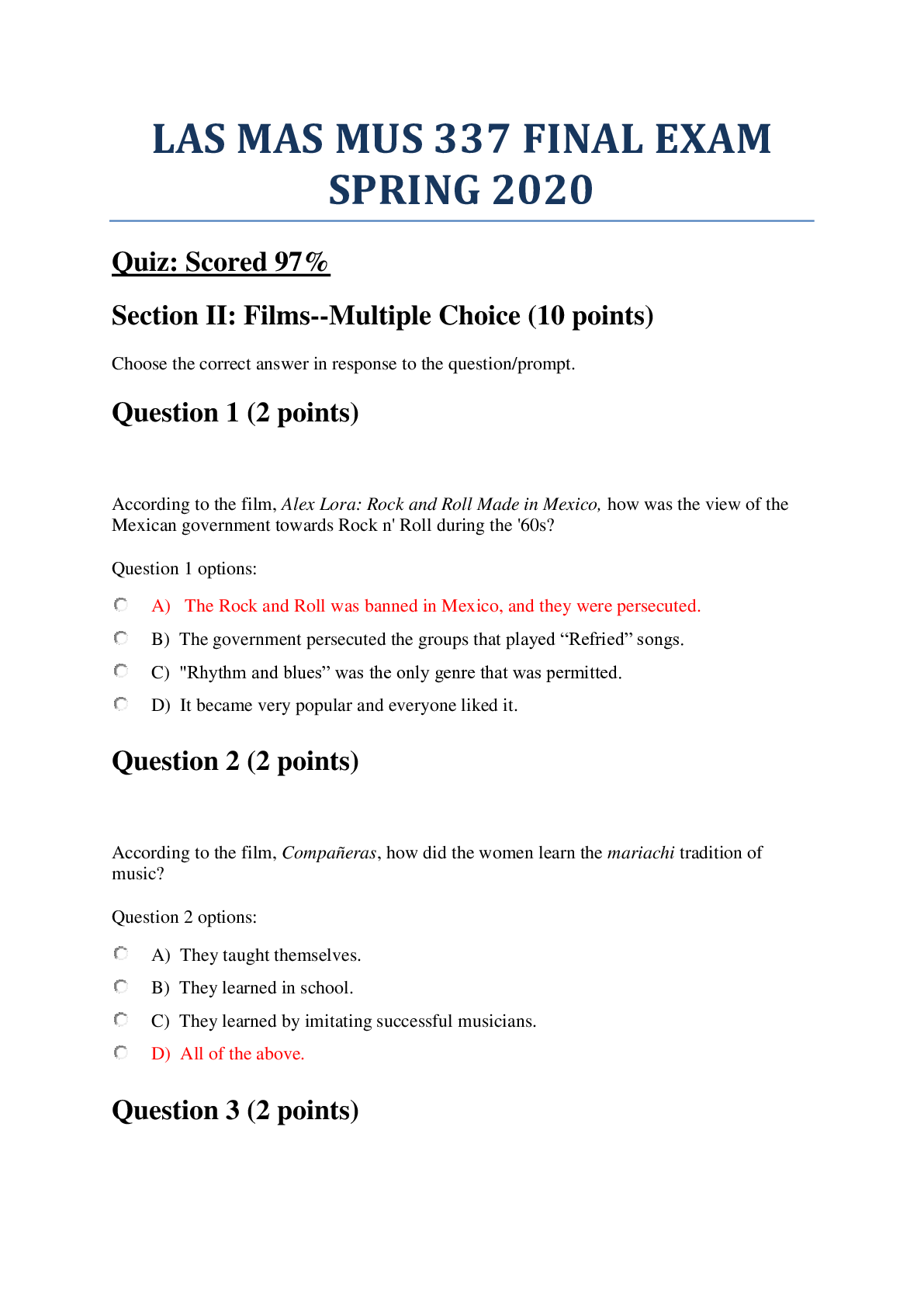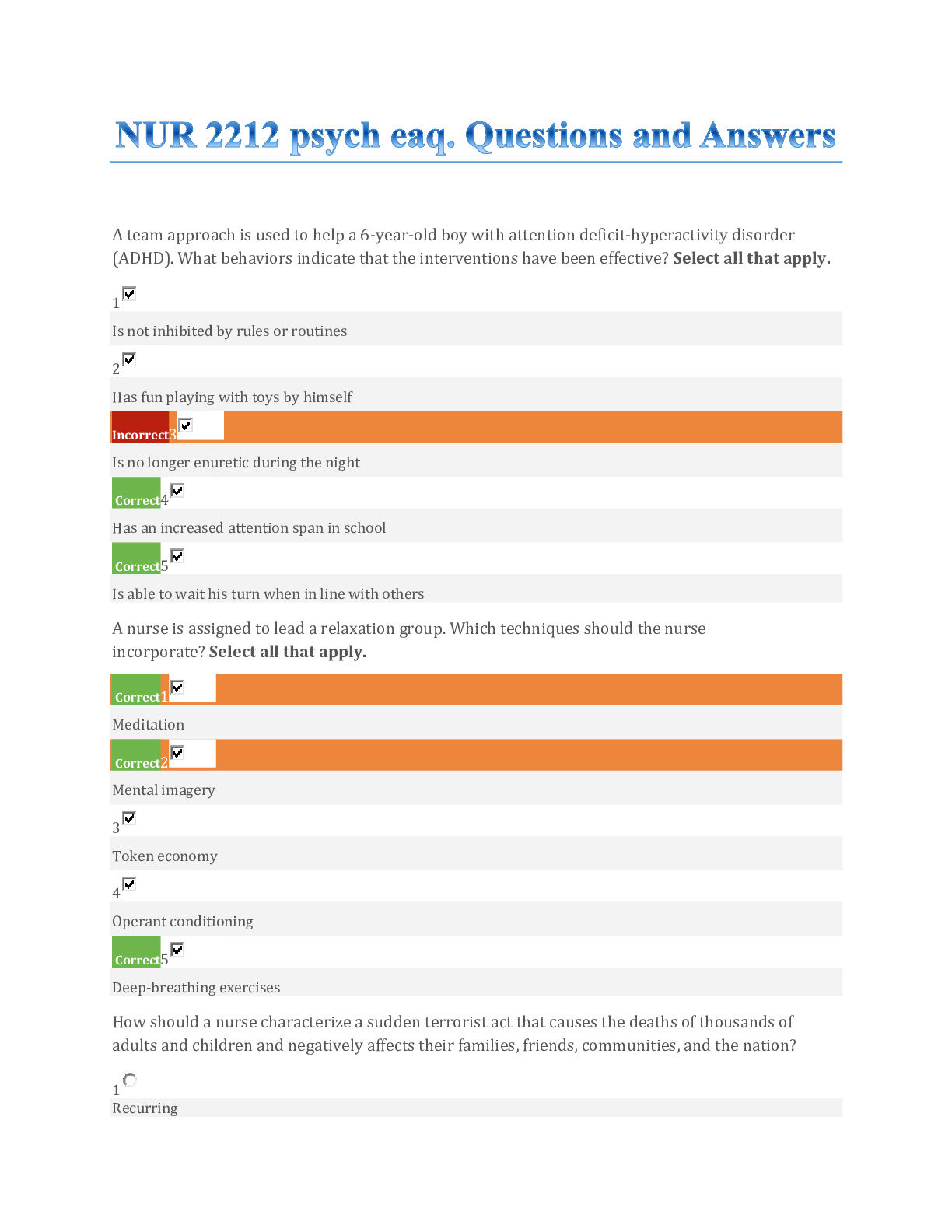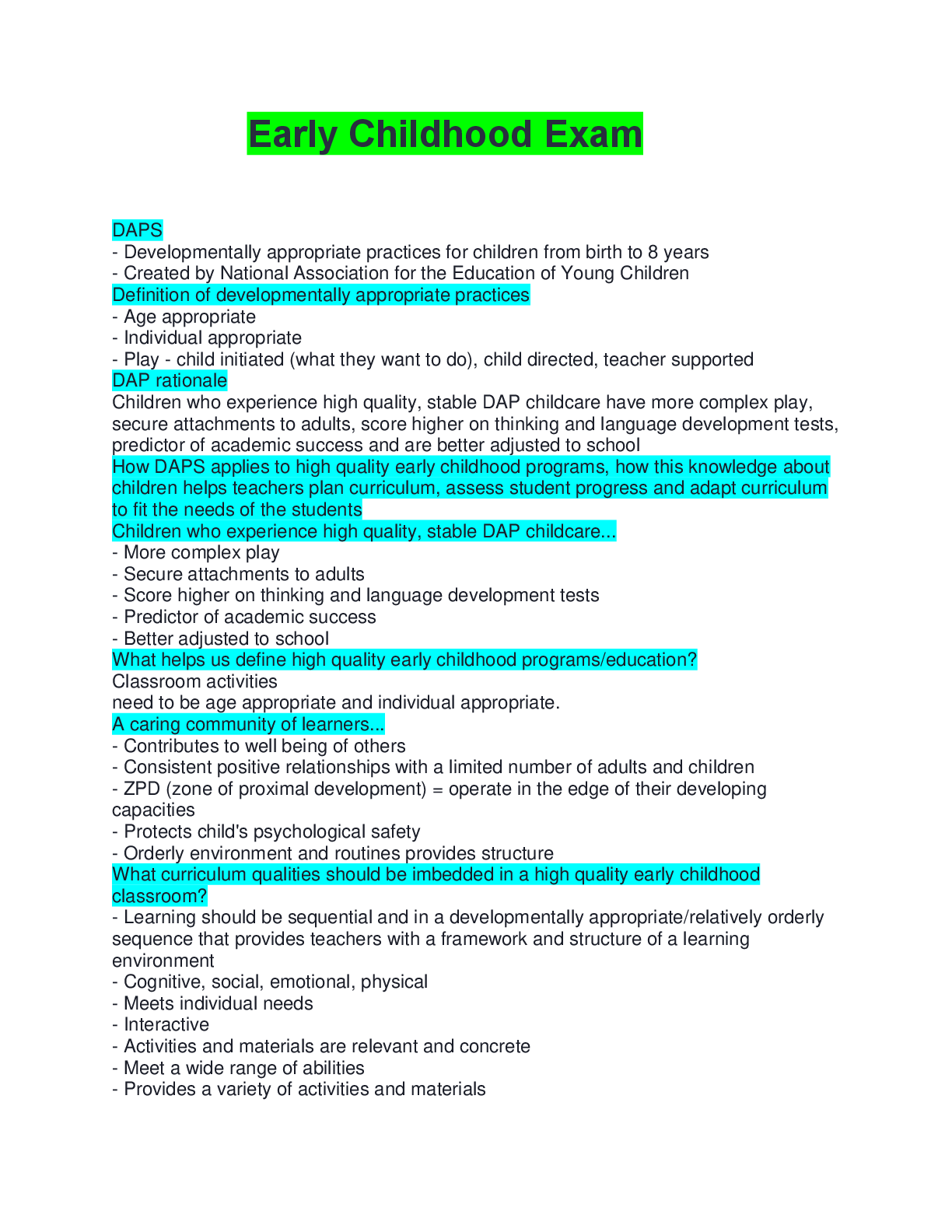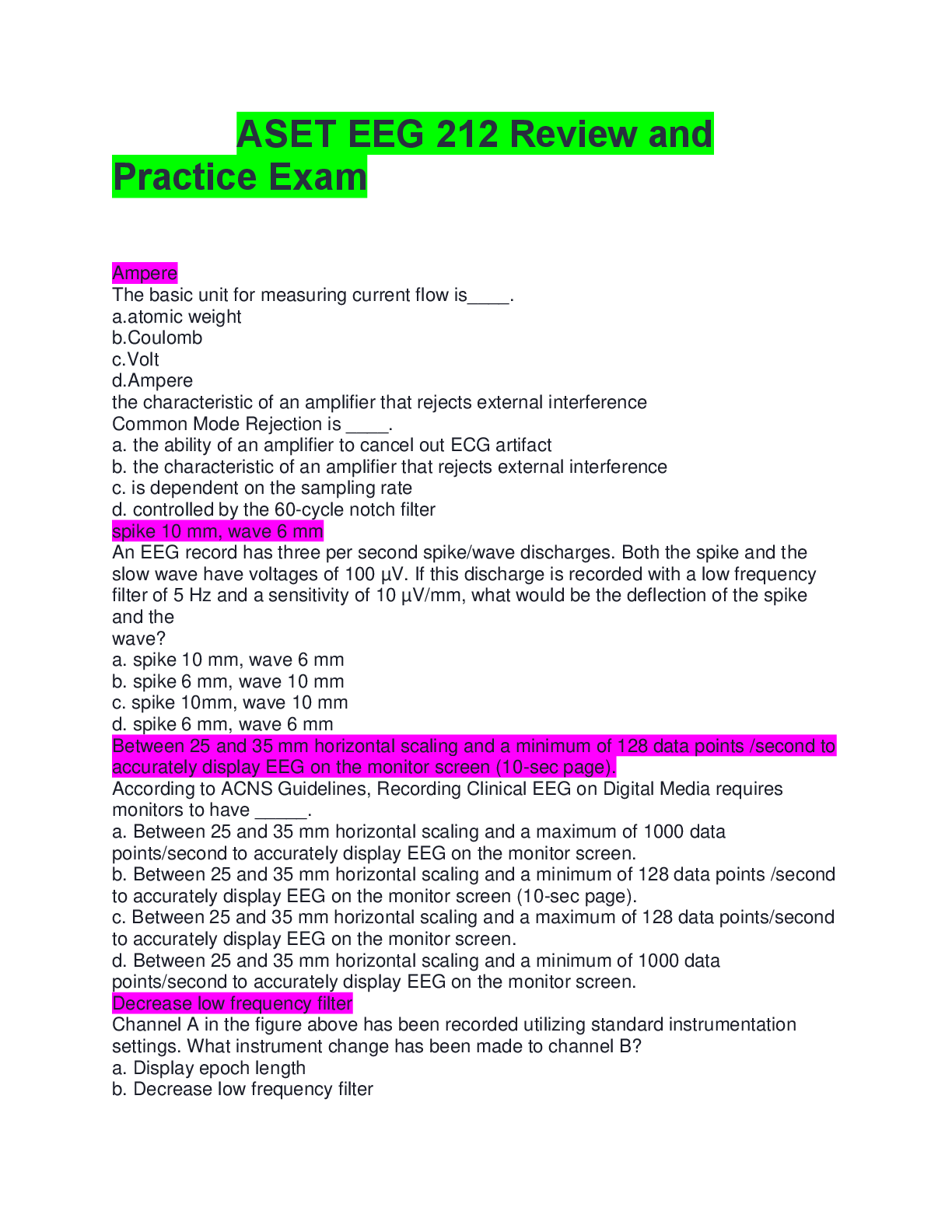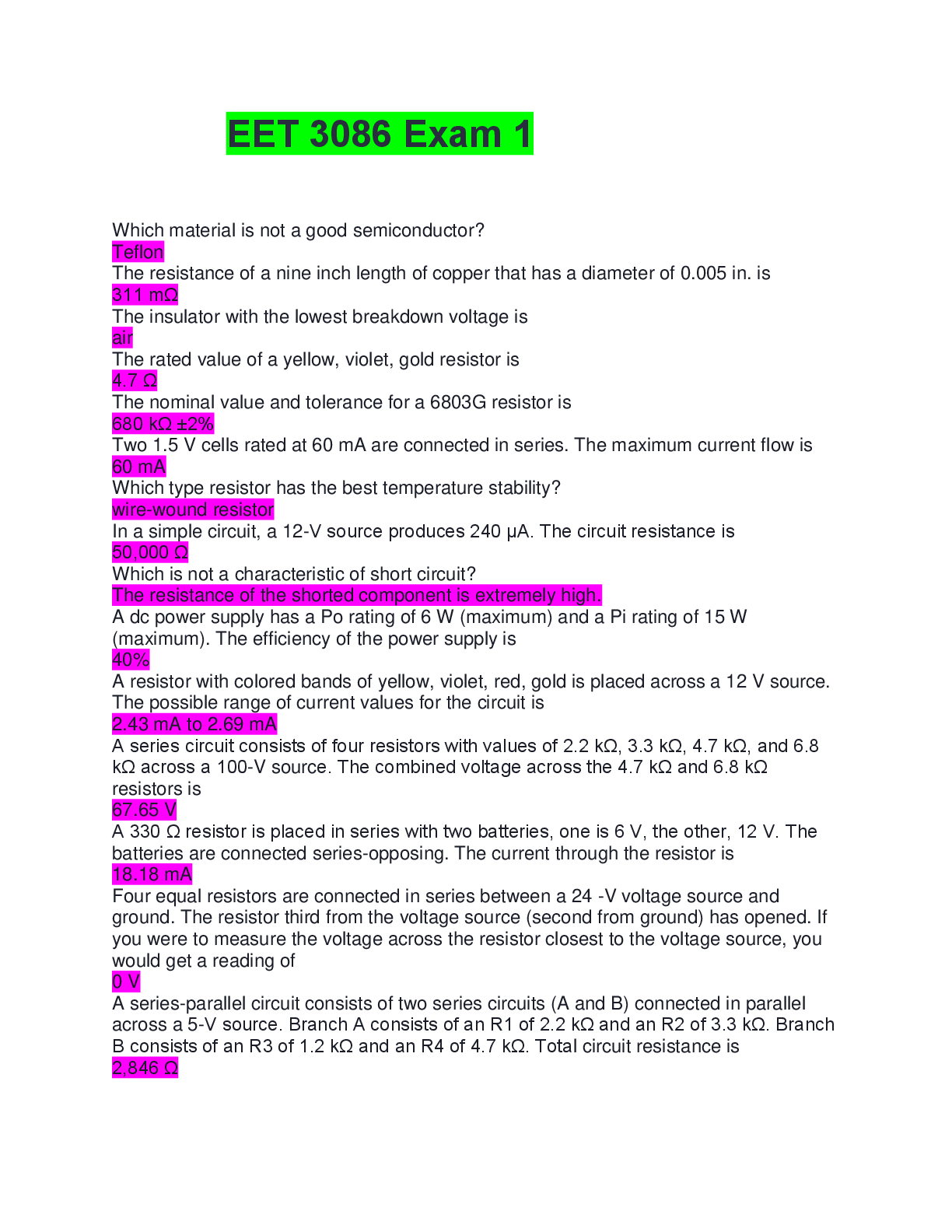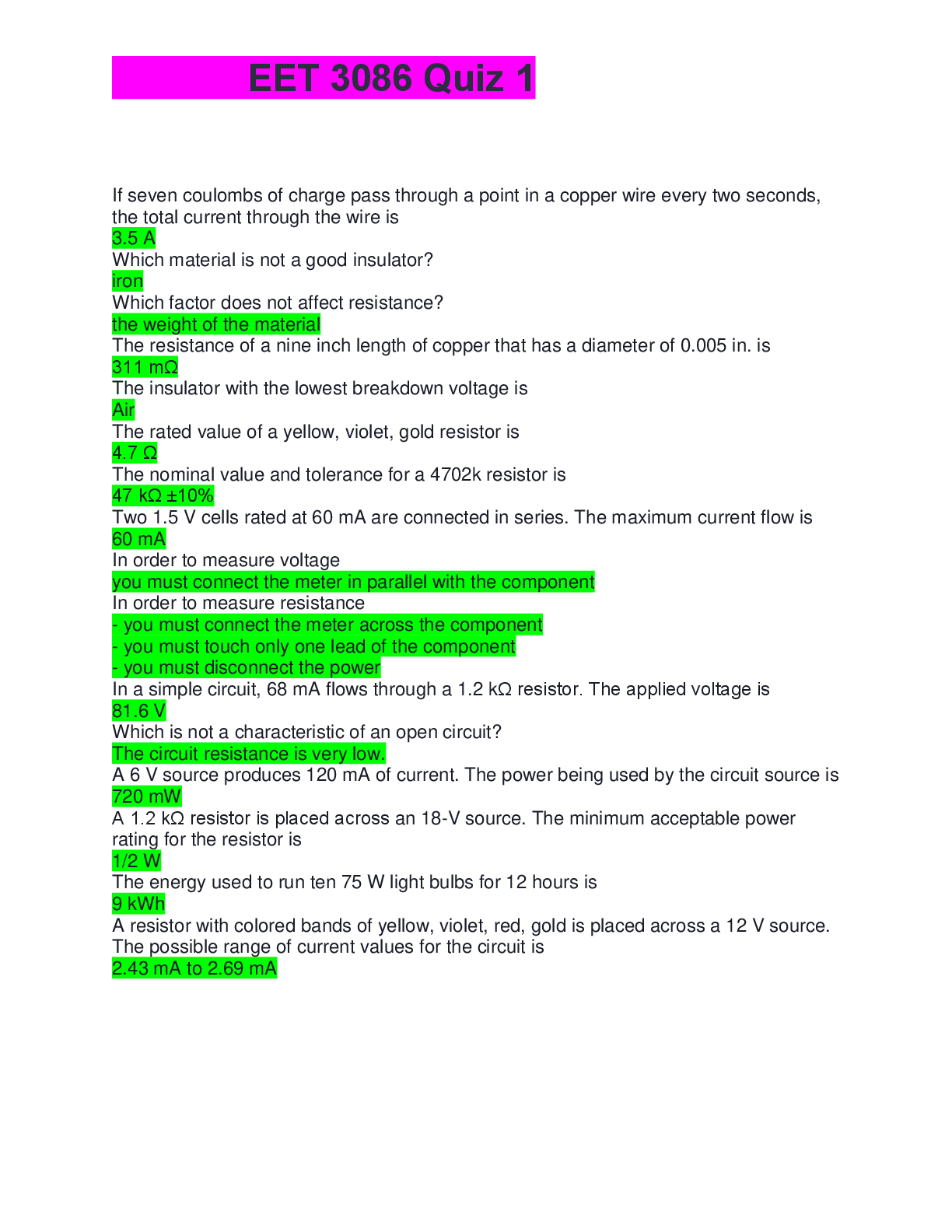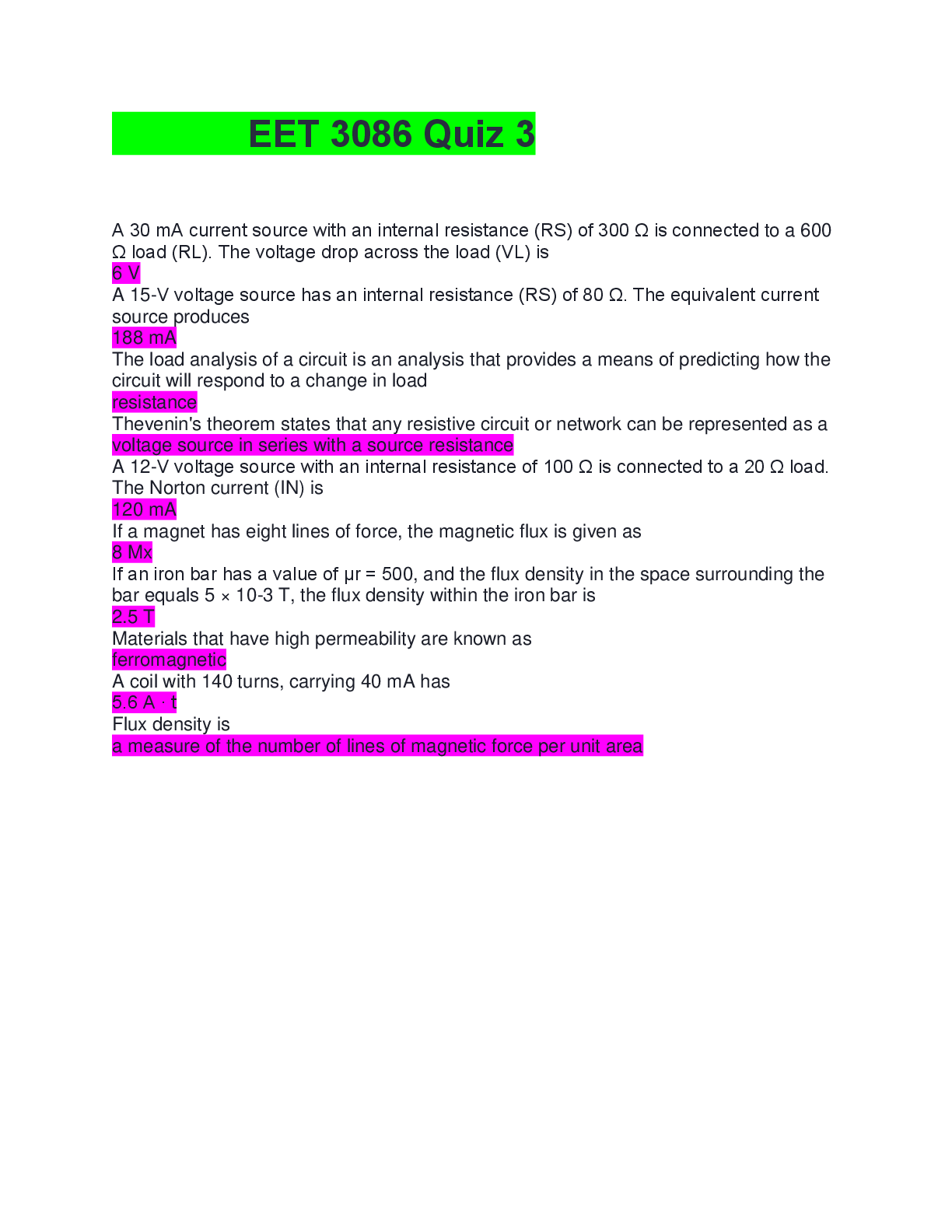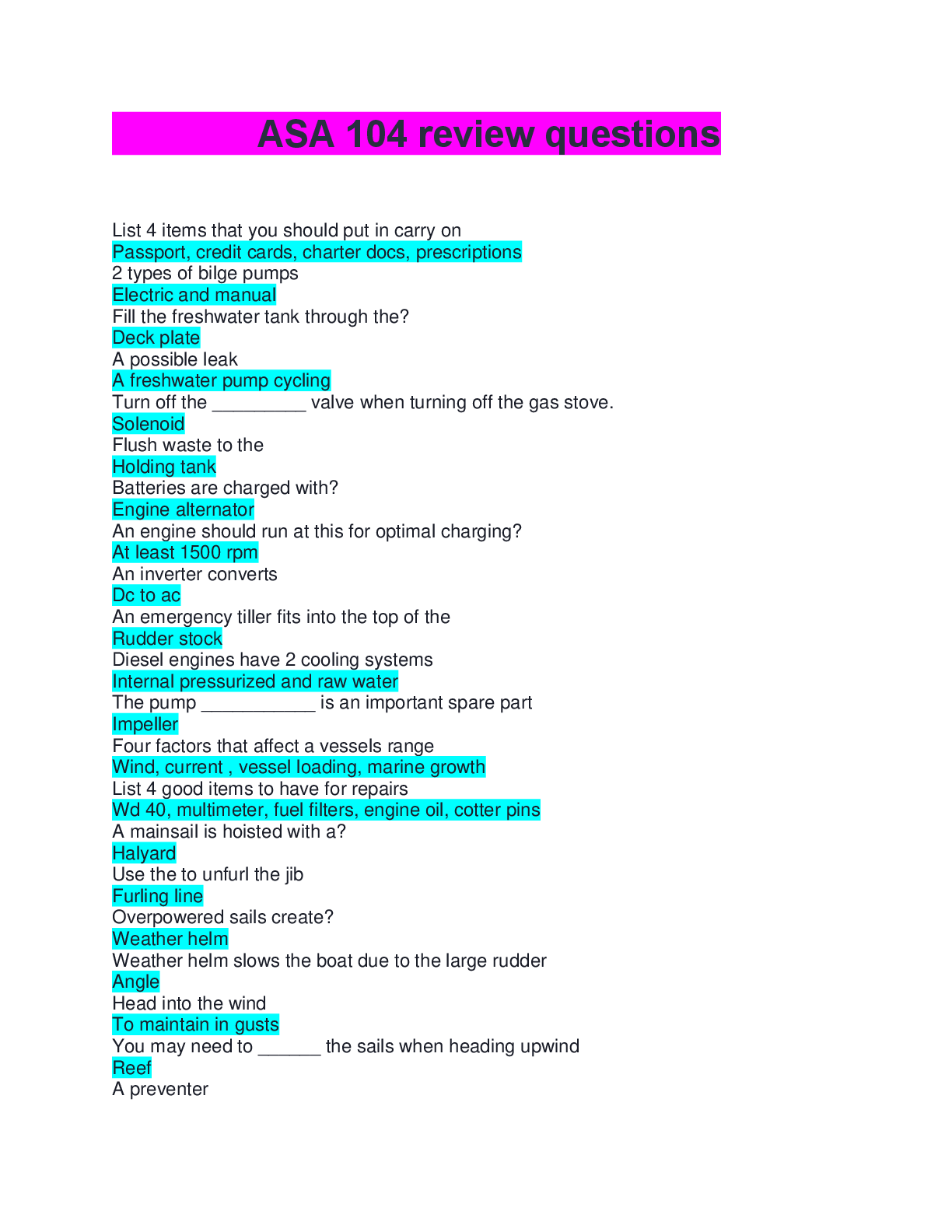Computer Science > EXAM > Operating System (OS) Quizes 1-14 | All Course Quizzes (All)
Operating System (OS) Quizes 1-14 | All Course Quizzes
Document Content and Description Below
Operating System (OS) Quizes 1-14 | All Course Quizzes Kennesaw State University Operating System (OS) Quizes 1-14 Points Awarded 36.00 Points Missed 0.00 � ... � Percentage 100% 1. The operating system manages each and every piece of hardware and software. A) True B) False 2. An operating system is a special type of hardware. A) True B) False 3. The Memory Manager, the Interface Manager, the User Manager, and the File Manager are the basis of all operating systems. A) True B) False 4. Networking was not always an integral part of operating systems. A) True B) False 5. The Memory Manager is in charge of main memory, also known as ROM. A) True B) False 6. The high-level portion of the Process Manager is called the Process Scheduler. A) True B) False 7. The Device Manager monitors every device, channel, and control unit. A) True B) False 8. The File Manager is responsible for data files but not program files. A) True B) False 9. When the Processor Manager receives a command, it determines whether the program must be retrieved from storage or is already in memory, and then notifies the appropriate manager. A) True B) False 10. Operating systems with networking capability have a fifth essential manager called the Network Manager that provides a convenient way for users to share resources while controlling users’ access to them. A) True B) False 11. The central processing unit (CPU) is the brains of the computer with the circuitry to control the interpretation and execution of instructions. A) True B) False 12. The supercomputer was developed primarily for government applications needing massive and fast number-crunching ability to carry out military operations and weather forecasting. A) True B) False 13. Real-time systems are used in time-critical environments where reliability is key and data must be processed within a strict time limit. A) True B) False 14. Many early programs used convoluted logic that only the original programmer could understand, so it was nearly impossible for anyone else to debug or change the program later on. A) True B) False 15. If the control unit has two buffers, the second buffer can be loaded while the first buffer is transmitting its contents to or from the CPU. A) True B) False 16. The ____ is unique to each operating system. A) User Interface B) Process Manager C) Memory Manager D) File Manager 17. The ____ allocates each resource, starts its operation, and, finally, deallocates the resource, making it available to the next process or job. A) Device Manager B) File Manager C) Keyboard Manager D) Memory Manager 18. ____ include(s) every peripheral unit in the system such as printers, disk drives, CD/DVD drives, flash memory, keyboards, and so on. A) The CPU B) I/O Devices C) Processors D) Secondary components 19. In a computer, the ____ holds the Central Processing Unit, the Arithmetic and Logic Unit, registers, cache, and main memory. A) parallel system B) USB interface C) tower D) monitor C 20. A supercomputer can perform ____ floating-point operations per second. A) 240 million B) 2.4 billion C) 2.4 trillion D) 24 trillion C 21. Powerful microcomputers developed for use by commercial, educational and government enterprises are called ____. A) supercomputers B) minicomputers C) terminals D) workstations D 22. ____ operating systems are typically used for a network platform. A) IRIX, UNICOS B) Linux, Macintosh, MS-DOS, Windows 2000/XP C) Linux, NetWare, UNIX, Windows D) IBM OS/390, UNIX C 23. The primary distinguishing characteristic of modern computers is ____. A) memory capacity B) processor capacity C) disk space D) physical size 24. ____ systems are used in time-critical environments where reliability is key and data must be processed within a strict time limit. A) Embedded B) Hybrid C) Interactive D) Real-time D 25. A hybrid system is a combination of the ____ systems. A) batch and interactive B) batch and real-time C) interactive and real-time D) real-time and general-purpose 26. ____ systems are computers placed inside other products to add features and capabilities. A) Real-time B) Interactive C) Embedded D) Hybrid C 27. Second-generation computers were developed to meet the needs of ____. A) home users B) businesses C) secondary education D) online users 28. ____ means that several logical records are grouped within one physical record. A) Grouping B) Fixing C) Combining D) Blocking D 29. The most common mechanism for implementing multiprogramming was the introduction of the ____ concept, which is when the CPU is notified of events needing operating systems services. A) paging B) sharing C) messaging D) interrupt D 30. A system with ____ divides programs into parts and keep them in secondary storage, bringing each part into memory only as it is needed. A) virtual memory B) shared memory C) segmented processing D) passive multiprogramming 31. The ____ is used to indicate that a program is permanently held in ROM (read only memory), as opposed to being held in secondary storage. A) hardware B) firmware C) software D) shareware 32. A typical ____ computer houses devices to perform audio, video, and graphic creation and editing. A) multiprocessor B) multimedia C) networked D) PDA 33. ____ is the partitioning of a single server, each of which can support a different operating system. A) Multiprocessing B) Multithreading C) Virtualization D) Shared processing C 34. A thread (or ____) can be defined as a unit smaller than a process, which can be scheduled and executed. A) heavyweight process B) lightweight process C) kernel D) distributor 35. The name for the nucleus of an operating system is the ____. A) manager B) center C) core D) kernel D 36. ____ are self-contained modules (units of software) that provide models of the real world and can be reused in different applications. A) Objects B) Kernels C) Peripherals D) Threads Continue Points Awarded 36.00 Points Missed 0.00 Percentage 100% 1. All computers have only a finite amount of memory and if a program doesn’t fit, then either the size of the main memory must be increased or the program must be modified. A) True B) False 2. To overlay is to transfer segments of a program from main memory into secondary storage for execution, so that two or more segments take turns occupying the same memory locations. A) True B) False 3. The first step in loading a job in a single‐user system is storing the first memory location of program into the base register (for memory protection). A) True B) False 4. A single‐user system supports multiprogramming. A) True B) False 5. The first attempt to allow for multiprogramming used fixed partitions. A) True B) False 6. The problem of partition intrusion is present in single‐user contiguous allocation schemes. A) True B) False 7. The algorithm used to store jobs into memory requires a few more steps than the one used for a single‐user system because the size of the job must be matched with the size of the partition to make sure it fits completely. A) True B) False 8. The fixed partition scheme does not require that the entire program be stored contiguously and in memory from the beginning to the end of its execution. A) True B) False 9. The fixed partition scheme works well if all of the jobs run on the system are of the same size or if the sizes are known ahead of time and don’t vary between reconfigurations. A) True B) False 10. In a fixed partition scheme, large jobs may have a longer turnaround time as they wait for free partitions of sufficient size or may never run. A) True B) False 11. The best‐fit allocation method keeps the free/busy lists organized by memory locations, low‐order memory to high‐order memory. A) True B) False 12. A large job can have problems with a first‐fit memory allocation list. A) True B) False 13. The best‐fit free list scheme uses memory more efficiently than the first‐fit free scheme but it is slower to implement. A) True B) False 14. The first‐fit algorithm assumes that the Memory Manager keeps only one list containing free memory blocks. A) True B) False 15. One of the problems with the best‐fit algorithm is that the entire table must be searched before the allocation can be made because the memory blocks are physically stored in sequence according to their location in memory. A) True B) False 16. For a fixed partition system, memory deallocation is quite complex. A) True B) False 17. In the relocatable dynamic partitions scheme, the Memory Manager relocates programs to gather together all of the empty blocks and compact them to make one block of memory large enough to accommodate some or all of the jobs waiting to get in. A) True B) False 18. Memory is allocated during garbage collection. A) True B) False 19. During compaction, the operating system must distinguish between addresses and data values, and the distinctions are not obvious once the program has been loaded into memory. A) True B) False 20. After relocation and compaction, both the free list and the busy list are updated. A) True B) False 21. Compaction should always be performed only when there are jobs waiting to get in. A) True B) False 22. The following,____, describes the first memory allocation scheme. A) Each program to be processed was loaded into secondary storage, then swapped into memory in parts B) Each program to be processed was partially loaded into memory, then granted more memory as needed C) Each program to be processed was allocated a portion of memory and could negotiate with other programs to access more memory D) Each program to be processed was loaded in its entirety into memory and allocated as much contiguous space in memory as it needed D 23. In a single‐user system, jobs are processed ____. A) sequentially B) intermittently C) randomly D) in order of longest job to shortest job 24. Fixed partitions are also called ____ partitions. A) complete B) static C) direct D) sized 25. In the partition scheme, the table that the Memory Manager uses to keep track of jobs is composed of the ____. A) partition size, memory address, and status B) status, access, and memory address C) partition size, status, and access D) partition size, memory address, access, and status 26. The fixed partition scheme works well ____. A) when jobs have the same size B) when jobs have different sizes C) when job sizes are not known in advance D) when all jobs are under 100K 27. ____ consists of fragments of free memory between blocks of allocated memory. A) An inefficient fit B) Indirect partitioning C) External fragmentation D) Internal fragmentation 28. The ____ keeps the free/busy lists organized by memory locations, low‐order memory to high‐order memory. A) fixed partition allocation B) first‐fit memory allocation C) dynamic fit memory allocation D) best‐fit memory allocation 29. ____ has the least wasted space and the smallest partition fitting the requirements. A) Fixed partitioning B) First‐fit memory allocation C) Dynamic fit memory allocation D) Best‐fit memory allocation 30. ____ is how memory is deallocated in a fixed partition scheme. A) Memory Manager releases the block and combines it with another free block. B) Memory Manager immediately gives memory to another program. C) Memory Manager adds block to free list and removes it from busy list. D) Memory Manager resets the status of the memory block where the job was stored to “free.” 31. In a dynamic partition scheme, ____, is how the Memory Manager deallocates a block that is between two other free blocks. A) the sizes of the three free partitions must be combined B) all three are moved individually from the busy list to the free list C) the block is combined with the larger of the two adjacent blocks D) the status of the block is set to free 32. When memory is deallocated, an entry can be removed from the free list by creating a(n) ____. A) blank line B) null entry C) joined entry D) empty entry 33. A(n) ____ in the busy list occurs when a memory block between two other busy memory blocks is returned to the free list. A) blank line B) null entry C) joined entry D) empty entry 34. The ____ of memory, sometimes referred to as garbage collection or defragmentation, is performed by the operating system to reclaim fragmented sections of the memory space. A) deallocation B) redirection C) compaction D) reallocation C 35. By compacting and relocating, the Memory Manager optimizes the use of memory and thus improves throughput, but an unfortunate side effect is more ____. A) null entries B) segmentation C) errors D) overhead D 36. One approach to performing compaction is to do it when a certain ____ of memory becomes busy. A) byte B) percentage C) bit D) area Continue Points Awarded 37.00 Points Missed 1.00 Percentage 97.4% 1. One sector will hold one page of job instructions and fit into one page frame of memory. A) True B) False 2. Paged memory allocation usually results in internal fragmentation, but never external fragmentation. A) True B) False 3. The Job Table (JT) contains two entries for each active job: the size of the job and the memory location where its Page Map Table is stored. A) True B) False 4. To find the address of a given program line, the line number is multiplied by the page size. A) True B) False 5. Each page of a job is actually stored in a page frame that can be located anywhere in available main memory. A) True B) False 6. To find the exact position of an instruction in memory, after the page number and displacement has been calculated, the operating system refers to the job’s PMT to find out which page frame contains the page. A) True B) False 7. The address of the beginning of a page frame is found by multiplying the page frame number by the number of frames. A) True B) False 8. Every time an instruction is executed, or a data value is used, the operating system (or the hardware) must translate the job space address, which is relative, into its physical address, which is absolute. A) True B) False 9. Demand paging was the first widely used scheme that removed the restriction of having the entire job in memory from the beginning to the end of its processing. A) True B) False 10. The key to the successful implementation of demand paging is the use of a direct access memory device that can work directly with the CPU. A) True B) False 11. Demand paging requires that the Page Map Table for each job keep track of each page as it is loaded or removed from main memory. A) True B) False 12. To move in a new page, a resident page must be swapped back into primary storage. A) True B) False 13. Demand paging offers a perfect solution to inefficient memory limitations. A) True B) False 14. The first-in first-out (FIFO) page replacement policy will remove the pages that have been in memory the shortest. A) True B) False 15. A page interrupt is generated when a new page is brought into memory. A) True B) False 16. When using a FIFO scheme, more memory will always result in better performance. A) True B) False 17. A variation of the LRU page replacement algorithm is known as the clock page replacement policy because it is implemented with a circular queue and uses a pointer to step through the reference bits of the active pages, simulating a clockwise motion. A) True B) False 18. The process of shifting bits to the right and resetting the leftmost bit to 1 when a page is referenced gives a history of each page’s usage. A) True B) False 19. A job’s working set is the set of pages residing in memory that can be accessed indirectly. A) True B) False 20. Within the Memory Manager the Segment Link Table lists details about each segment (one for each job). A) True B) False 21. The segmented/demand paged memory allocation scheme offers the logical benefits of segmentation, as well as the physical benefits of paging. A) True B) False 22. In general, when a job is allocated to the CPU its Page Map Table is loaded into main memory while the Segment Map Tables are loaded only as needed. A) True B) False 23. The use of virtual memory requires cooperation between the Memory Manager (which tracks each page or segment) and the processor hardware (which issues the interrupt and resolves the virtual address). A) True B) False 24. A typical microprocessor has 5-6 levels of cache memory. A) True B) False 25. The optimal selection of cache size and replacement algorithm can result in 80 to 90 percent of all requests being in the cache. A) True B) False 26. The primary advantage of storing programs in noncontiguous locations is that ____. A) multiple programs can run at the same time B) every program will be able to run C) secondary storage is accessed more quickly D) main memory is used more efficiently D 27. If the page size is 100 bytes,____ is the displacement for byte 214 of a program. A) 0.5 B) 2 C) 14 D) 21400 C 28. Assume that the Page Map Table below is in effect. The number of lines per page is 400. The actual memory location for line 433 is ____. Job Page Number Page Frame Number 0 8 1 10 2 5 3 11 A) 1 B) 33 C) 4000 D) 4033 Points Earned: 0.0/1.0 D 29. A page size that is too small will generate ____. A) very long PMTs B) excessive internal fragmentation C) more difficult to calculate actual position D) excessive external fragmentation 30. With demand paging, jobs are divided into equally sized ____ that initially reside in secondary storage. A) pages B) blocks C) frames D) sets 31. One of the most important innovations of demand paging was that it made ____ feasible. A) memory demand B) virtual demand C) virtual paging D) virtual memory D 32. In demand paging when a job requires a certain page to be loaded and there is no empty page frame,____. A) a resident page must be swapped back into secondary storage B) the page cannot be loaded and the job will exit C) the job must wait until a page frame is freed by another job D) the page will share a page frame with another page from the same job 33. When there is an excessive amount of page swapping between main memory and secondary storage, the operation becomes inefficient, which is called ____. A) excessive demand paging B) hot swapping C) thrashing D) overswapping C 34. The ____ policy is based on the theory that the best page to remove is the one that has been in memory the longest. A) TRU B) LRU C) LIFO D) FIFO D 35. To access a location in memory when using segmented memory management, the address is composed of two entries: ____. A) the segment number and the line number B) the segment number and the displacement C) the line number and the displacement D) the segment number, the line number, and the displacement 36. ____ gives users the appearance that their programs are being completely loaded in main memory during their entire processing time. A) Segmenting B) Virtual memory C) Shared memory D) Multithreading 37. Studies have shown that having any ____, even a small one, can substantially improve the performance of the computer system. A) cache B) memory block C) page block D) block 38. The cache hit ratio is ____, if the total number of requests is 10 and 6 of those are found in cache memory. A) 6% B) 10% C) 60% D) 100% C Continue Points Awarded 39.00 Points Missed 0.00 Percentage 100% 1. A process is an inactive unit, such as a file stored on a disk. A) True B) False 2. A program is an active entity that requires a set of resources, including a processor and special registers, to perform its function. A) True B) False 3. The processor is also known as the CPU. A) True B) False 4. A single processor can be shared by several jobs, or several processes, but if, and only if, the operating system has a scheduling policy, as well as a scheduling algorithm, to determine when to stop working on one job and proceed to another. A) True B) False 5. The Processor Manager is a composite of two submanagers: one in charge of job scheduling and the other in charge of program scheduling. A) True B) False 6. After a job has been placed on the READY queue by the Job Scheduler, the Process Scheduler takes over. A) True B) False 7. Most computer programs alternate between CPU cycles and I/O cycles. A) True B) False 8. CPU-bound jobs (such as printing a series of documents) have many brief CPU cycles and long I/O cycles. A) True B) False 9. As a job moves through the system it is always in one of five states (or at least three); these are called the job status or the process status. A) True B) False 10. From HOLD, the job moves to WAITING when it’s ready to run but is waiting for the CPU. A) True B) False 11. The transition from one job or process status to another is initiated by either the Job Scheduler or the Process Scheduler. A) True B) False 12. Each job is uniquely identified by the user’s identification and a pointer connecting it to its descriptor. A) True B) False 13. The process state contains all of the data about the job needed by the operating system to manage the processing of the job. A) True B) False 14. It is possible to minimize response time by running only interactive jobs and letting the batch jobs wait until the interactive load ceases. A) True B) False 15. The Process Scheduler often uses a timing mechanism and periodically interrupts running processes when a predetermined slice of time has expired. A) True B) False 16. First-come, first-served (FCFS) is a preemptive scheduling algorithm that handles jobs according to their arrival time. A) True B) False 17. If one job monopolizes the system, the extent of its overall effect on system performance depends on the scheduling policy and whether the job is CPU-bound or I/O-bound. A) True B) False 18. Shortest job next (SJN) is a nonpreemptive scheduling algorithm (also known as shortest job first, or SJF) that handles jobs based on the length of their CPU cycle time. A) True B) False 19. When using priority scheduling, priorities are assigned to jobs by the owner of the job (the user). A) True B) False 20. The shortest remaining time (SRT) algorithm is often used in interactive systems. A) True B) False 21. Context switching is required by all preemptive algorithms. A) True B) False 22. In round robin scheduling, if processing isn’t finished when time expires, the job is preempted and put at the end of the READY queue and its information is saved in its PCB. A) True B) False 23. Multiple-level queues isn’t really a separate scheduling algorithm but works in conjunction with several other schemes. A) True B) False 24. Aging is used to ensure that jobs in lower-level queues will eventually complete their execution. A) True B) False 25. The control program that handles the interruption sequence of events is called the interrupt scheduler. A) True B) False 26. A ____ is a portion of a process that can run independently. A) thread B) program C) miniprocess D) subprocess 27. The ____ is also called the high-level scheduler. A) Process Scheduler B) Job Scheduler C) Program Scheduler D) Thread Scheduler 28. The Job Scheduler seeks to ____, when scheduling jobs. A) run all CPU intensive jobs first B) run all I/O intensive jobs first C) balance CPU and I/O intensive jobs D) run the quickest jobs first C 29. In a highly interactive environment there is a third layer of the Processor Manager called the ____ scheduler. A) Managing B) Subprocess C) middle-level D) Program C 30. When the job is accepted by the system, it’s put on ____ and placed in a queue. A) HOLD B) RUNNING C) WAITING D) READY 31. The transition from ____ is initiated by the Job Scheduler according to some predefined policy. A) READY to RUNNING B) RUNNING to WAITING C) RUNNING back to READY D) HOLD to READY D 32. The transition from ____ is initiated by the Process Scheduler or the Job Scheduler. A) WAITING to READY B) RUNNING to WAITING C) RUNNING to FINISHED D) HOLD to READY C 33. ____ holds pertinent information, including the address where the job is stored and, in the case of virtual memory, the mapping between virtual and physical memory locations. A) Main memory B) Register content C) Process priority D) The process state 34. ____ contains information used mainly for billing purposes and performance measurement. A) Accounting B) Process State C) Process Identification D) Process Status 35. Queues use ____ to track jobs the same way customs officials use passports to track international visitors. A) jobs B) processes C) PCBs D) record identifiers C 36. An I/O request is called a(n) ____ wait in multiprogramming environments. A) forced B) natural C) scheduled D) indirect 37. First-come, first-served (FCFS) is a very simple algorithm to implement because it ____. A) uses a FIFO queue B) uses a LIFO queue C) uses a circular queue D) uses a directed graph 38. The first-come, first-served (FCFS) algorithm is fine for most ____ systems. A) multiuser B) user initiated C) interactive D) batch D 39. Some systems increase the priority of jobs that have been in the system for an unusually long time to expedite their exit, which is known as ____. A) lagging B) aging C) bumping D) accelerated priority Continue Points Awarded 38.00 Points Missed 1.00 Percentage 97.4% 1. Deadlock is a system-wide tangle of resource requests that begins when two or more jobs are put on hold, each waiting for a vital resource to become available. A) True B) False 2. Deadlock does not usually affect the entire system. A) True B) False [Show More]
Last updated: 6 months ago
Preview 10 out of 144 pages

Loading document previews ...
Buy this document to get the full access instantly
Instant Download Access after purchase
Buy NowInstant download
We Accept:

Reviews( 0 )
$10.00
Can't find what you want? Try our AI powered Search
Document information
Connected school, study & course
About the document
Uploaded On
Nov 13, 2022
Number of pages
144
Written in
All
Additional information
This document has been written for:
Uploaded
Nov 13, 2022
Downloads
0
Views
194

